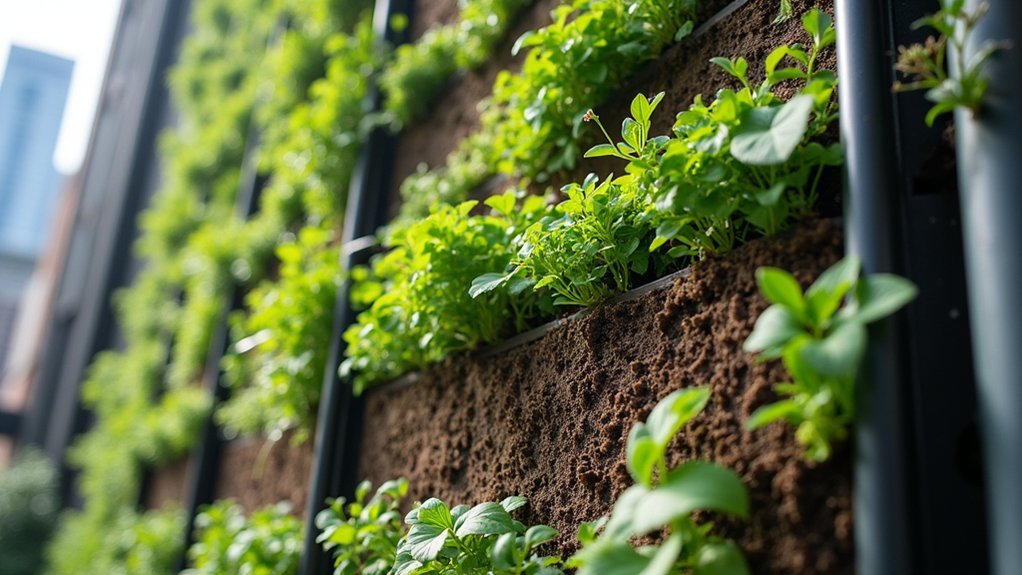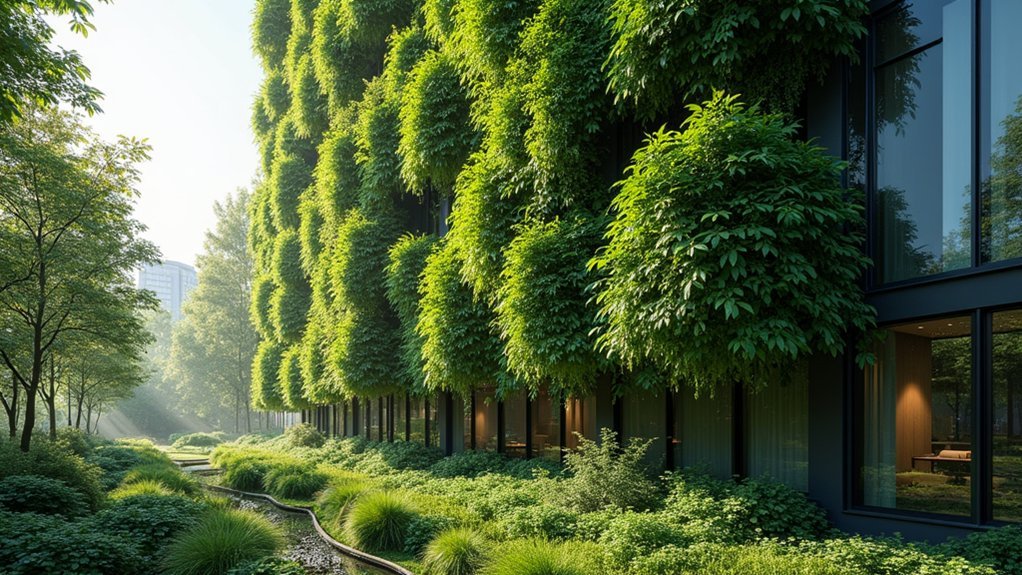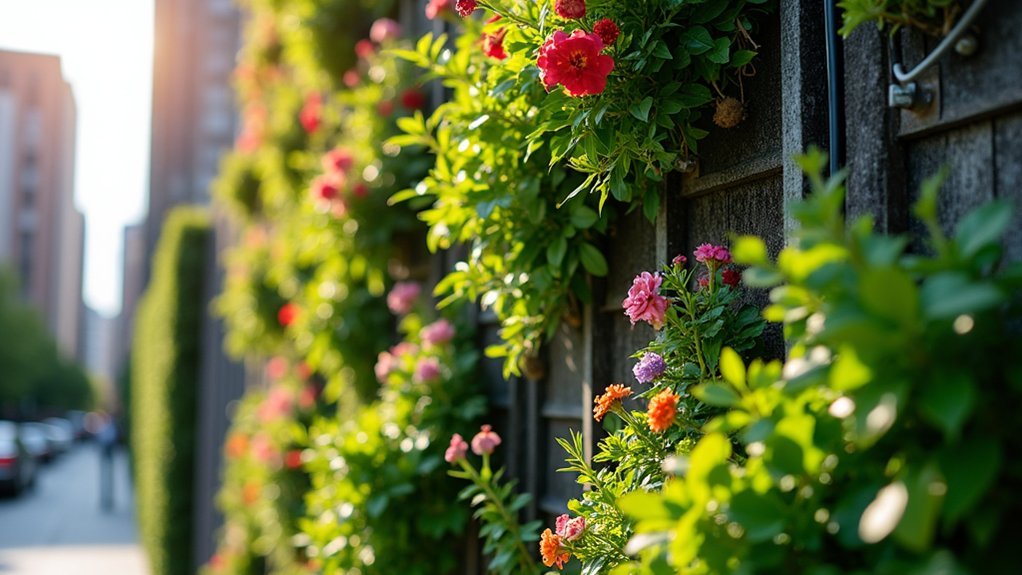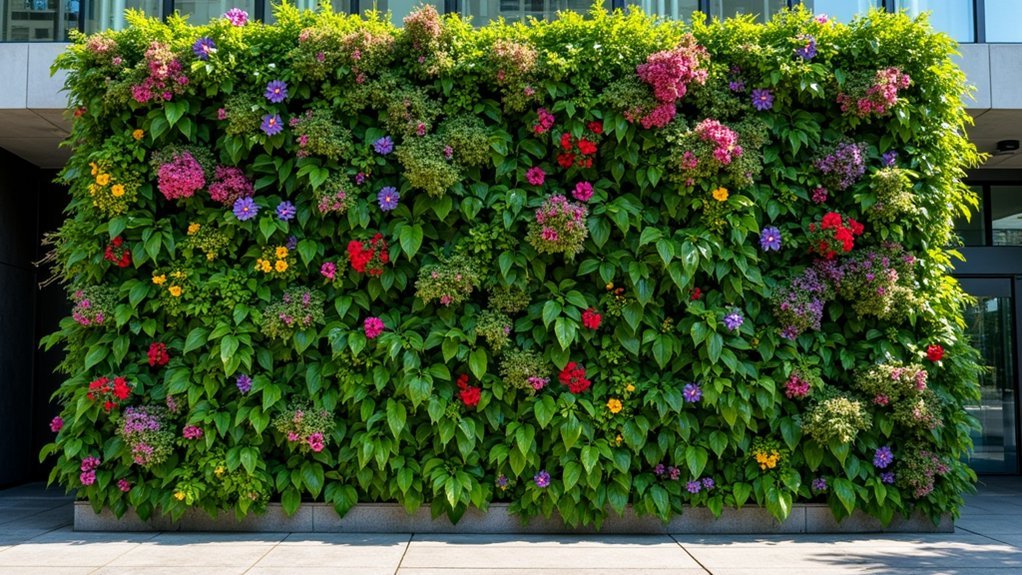Living walls in cities face regulation due to safety, structural integrity, and fire hazards concerns. You’ll need to comply with building codes, water management guidelines, and environmental impact assessments that guarantee these installations don’t damage buildings or introduce invasive species. They must meet fire safety standards (Class B-s2-d0 rating) and include proper drainage systems. Beyond legal requirements, these regulations help maximize the walls’ benefits like pollution filtration and biodiversity enhancement while minimizing risks.
Safety and Structural Integrity Standards for Urban Green Walls

While living walls have gained popularity as sustainable urban design elements, they must adhere to rigorous safety and structural integrity standards before installation.
You’ll find that these vertical gardens require compliance with fire safety standards, typically needing to achieve a Class B-s2-d0 rating to minimize fire risks in urban environments.
Building codes emphasize structural integrity through modular designs that can support dense vegetation while withstanding environmental stresses like wind and rain.
Your living wall must integrate with existing building structures without compromising overall stability.
Additionally, environmental standards require non-toxic materials and proper drainage systems to prevent harmful runoff.
Environmental Impact Assessments of Vertical Gardens
Before installing a living wall in urban environments, you’ll need to conduct thorough Environmental Impact Assessments (EIAs) to quantify their ecological contributions.
These assessments help guarantee your vertical garden complies with local regulations while maximizing urban greening benefits.
EIAs evaluate your living wall’s potential to:
- Filter up to 95% of vehicle and industrial pollutants, substantially improving local air quality
- Create habitats that enhance biodiversity and urban ecological balance
- Reduce building heating demands by up to 59%, mitigating urban heat island effects
- Increase property values by up to 20% while enhancing community wellbeing
- Contribute to municipal sustainability targets through quantifiable environmental benefits
Water Management Guidelines for Living Barriers

Effective water management forms the foundation of sustainable living walls in urban environments. When installing these green features, you’ll need to comply with regulations that mandate efficient drainage systems to prevent water damage to building structures.
In urban areas, guidelines often require you to incorporate integrated hydroponics and rainwater harvesting, reducing water consumption compared to traditional landscaping.
You’ll typically need to use soil substrates that enhance water retention while supporting plant health with minimal irrigation.
Most regulations promote biodiversity by requiring native plant species that naturally thrive in local climatic conditions.
Your living wall will also need to address stormwater management requirements, as these vertical gardens filter pollutants from rainwater and reduce runoff before it enters urban drainage systems.
Zoning Restrictions and Permit Requirements
When installing a living wall on your property, you’ll need to guarantee it complies with local architectural codes that regulate materials, dimensions, and visual integration with surrounding structures.
You may encounter challenges if your design conflicts with established neighborhood aesthetics, requiring you to apply for planned development variances that demonstrate how your living wall contributes positively to the area.
Working with an architect familiar with green infrastructure regulations can help you navigate these requirements and develop a compliant design that satisfies both your vision and municipal guidelines.
Architectural Code Compliance
As urban spaces increasingly adopt living walls, steering through the complex web of architectural regulations has become essential for successful implementation.
You’ll need to guarantee your living walls comply with building codes that typically require specific fire safety ratings, usually Class B-s2-d0, to mitigate potential hazards in densely populated areas.
- Verify that your installation meets structural load-bearing requirements
- Confirm compatibility with existing building envelope systems
- Guarantee irrigation systems comply with water management regulations
- Check that plant selections align with biodiversity planning policies
- Verify materials meet sustainability certification standards like BREEAM or WELL
Understanding these technical requirements early in your design process helps avoid costly adjustments later.
Most architectural planning policies now recognize living walls as legitimate building elements, but they must integrate seamlessly with the building’s overall safety and sustainability systems.
Planned Development Variances
Maneuvering zoning restrictions and permit requirements presents one of the most significant challenges for living wall implementation in urban environments.
You’ll need to navigate regulations that specify appropriate heights, materials, and maintenance protocols to guarantee your installation aligns with urban planning goals.
When standard zoning laws don’t accommodate your innovative design, you’ll need to pursue planned development variances.
These exceptions allow you to deviate from rigid requirements while still addressing safety concerns and aesthetic coherence.
You’ll likely need to demonstrate how your living wall contributes to sustainability standards like BREEAM or LEED certification.
Be prepared to complete environmental assessments examining ecosystem impacts and water management strategies.
Many municipalities require compliance with fire safety regulations, such as Class B-s2-d0 ratings, to mitigate potential hazards to adjacent structures.
Maintenance and Inspection Protocols for City Greenery

Regular pruning of your living wall isn’t just about aesthetics—it’s a legal requirement in most cities that guarantees plant health and prevents overgrowth onto public spaces.
You’ll need to schedule professional maintenance at least quarterly to meet municipal standards, with many cities requiring formal documentation of these pruning sessions.
Safety compliance checks for structural integrity, irrigation systems, and pest control must be performed biannually by certified inspectors who verify your installation isn’t posing hazards to pedestrians or building infrastructure.
Scheduled Pruning Requirements
When cities implement living walls, they must establish clear pruning schedules to maintain both aesthetics and plant health.
You’ll need to follow these scheduled pruning requirements to guarantee your living wall contributes positively to reducing the urban heat island effect without becoming a hazard.
- Trim your plants at least once or twice yearly based on species and growth rates
- Conduct regular inspections to catch pest issues or diseases early
- Check irrigation systems and soil health as part of your maintenance protocols
- Replace any dead vegetation promptly to maintain biodiversity
- Document all maintenance activities to comply with municipal regulations
Failing to meet these requirements can result in penalties or even forced removal of your living wall.
Cities enforce these standards to balance the environmental benefits with public safety considerations.
Safety Compliance Checks
To maintain public safety and structural integrity, living walls require rigorous compliance checks that go beyond basic maintenance.
You’ll need to verify your installation meets the required Class B-s2-d0 fire rating, guaranteeing all materials are fire retardant and suitable for urban environments.
Bi-annual inspections are essential for evaluating structural stability and plant health.
During these checks, you must assess the irrigation system’s functionality to prevent water waste or potential flooding issues.
Your urban greening initiatives should also undergo biodiversity evaluations to confirm they’re providing adequate habitats for pollinators as required by local regulations.
Don’t overlook noise pollution reduction capabilities—regular assessments guarantee your living wall maintains its soundproofing effectiveness.
These thorough safety compliance measures protect both the public and the long-term viability of your green infrastructure investment.
Plant Species Control and Invasive Prevention Measures
Although living walls offer remarkable aesthetic and environmental benefits for urban environments, they require careful plant selection to prevent ecological disruption.
When you install a living wall, you’ll need to comply with local regulations that control plant species used in these installations. Cities enforce these rules to maintain biodiversity and ecological balance in urban settings.
- You must typically use native plant species that support local wildlife and pollinators.
- Aggressive or harmful species are prohibited to protect native plant communities.
- Adherence to environmental regulations is mandatory to prevent habitat degradation.
- Prevention measures help control the spread of invasive species that could disrupt ecosystems.
- Your living wall installation should contribute positively to urban biodiversity rather than introducing ecological threats.
These plant species control measures guarantee living walls enhance rather than harm our urban environments.
Fire Safety Regulations for Vegetated Facades

Since living walls add organic material to building exteriors, they must meet stringent fire safety standards to protect urban structures.
You’ll find that most living walls achieve a Class B-s2-d0 fire rating, making them suitable for urban environments while maintaining compliance with safety codes.
When designing vegetated facades, you’re required to incorporate fire retardant materials in the modular structure.
These materials considerably reduce fire spread risks in dense urban settings.
Fire safety regulations mandate that your living wall installation won’t contribute to ignition or fire propagation, which means careful selection of both plants and construction materials.
Comprehensive strategy guides can help you navigate these requirements while also meeting broader building standards like BREEAM and WELL, effectively balancing safety, aesthetics, and sustainability in your living wall projects.
Accessibility and Public Health Considerations
Moving beyond fire prevention concerns, accessibility and public health impacts form significant components of living wall regulations in urban settings.
You’ll find these green installations can transform urban environments by filtering up to 95% of pollutants, creating cleaner air for you and your community. Properly designed living walls must comply with accessibility standards, ensuring everyone benefits from these green spaces regardless of mobility limitations.
- Reduce community crime rates by 7-8% through increased green space presence
- Decrease employee sick leave by 68 hours annually when nature views are accessible
- Filter 95% of vehicle and industrial pollutants, drastically improving air quality
- Support critical biodiversity by providing habitats for pollinators and wildlife
- Enhance public health outcomes through improved mental well-being and stress reduction
Frequently Asked Questions
What Is the Point of a Living Wall?
Living walls improve your air quality, reduce building temperatures, save you energy costs, create wildlife habitats, enhance property values, and beautify urban spaces. They’re a sustainable solution that supports both environmental and economic benefits.
What Are the Disadvantages of Living Walls?
You’ll face high costs for installation and maintenance, potential structural challenges, and risks of dampness or mold issues. Poor plant selection requires frequent care, and you might encounter regulatory hurdles with building codes.
How Long Do Living Walls Last?
Living walls typically last 5-15 years depending on your plant selection and maintenance routine. You’ll extend their lifespan with quality materials, regular care, and proper irrigation systems. Some manufacturers even offer 5-10 year warranties.
Are Living Walls Worth It?
Yes, living walls are worth it. You’ll see increased property values, reduced energy costs, improved air quality, enhanced aesthetics for your business, and better employee productivity. They’re an investment that pays off environmentally and financially.
In Summary
You’ll find that living walls need regulation to protect everyone’s safety, prevent structural damage, and manage environmental impacts. As you navigate permit processes and maintenance requirements, you’re helping guarantee these green features enhance urban landscapes without creating hazards. By following established guidelines for water usage, plant selection, and fire safety, you’re contributing to sustainable, safe city environments that benefit all residents.





Leave a Reply